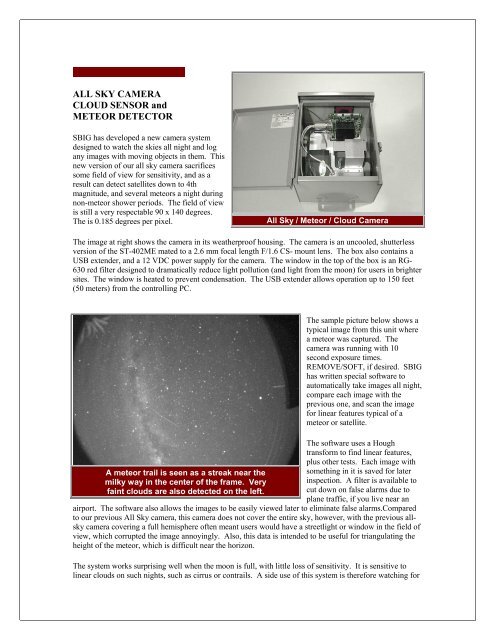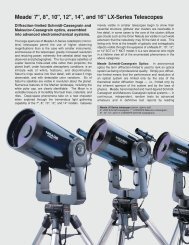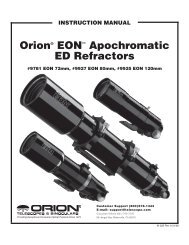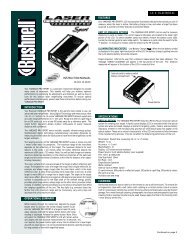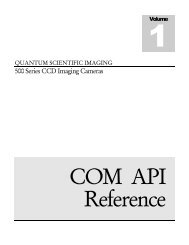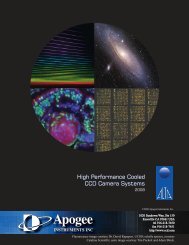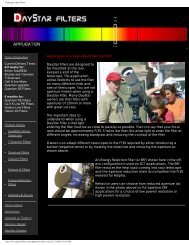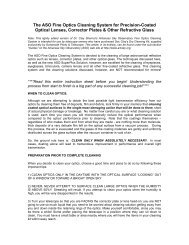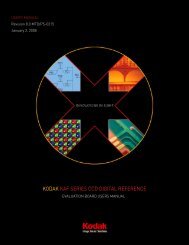ALL SKY CAMERA CLOUD SENSOR and METEOR DETECTOR
ALL SKY CAMERA CLOUD SENSOR and METEOR DETECTOR
ALL SKY CAMERA CLOUD SENSOR and METEOR DETECTOR
You also want an ePaper? Increase the reach of your titles
YUMPU automatically turns print PDFs into web optimized ePapers that Google loves.
…………………………………...<br />
<strong>ALL</strong> <strong>SKY</strong> <strong>CAMERA</strong><br />
<strong>CLOUD</strong> <strong>SENSOR</strong> <strong>and</strong><br />
<strong>METEOR</strong> <strong>DETECTOR</strong><br />
SBIG has developed a new camera system<br />
designed to watch the skies all night <strong>and</strong> log<br />
any images with moving objects in them. This<br />
new version of our all sky camera sacrifices<br />
some field of view for sensitivity, <strong>and</strong> as a<br />
result can detect satellites down to 4th<br />
magnitude, <strong>and</strong> several meteors a night during<br />
non-meteor shower periods. The field of view<br />
is still a very respectable 90 x 140 degrees.<br />
The is 0.185 degrees per pixel.<br />
All Sky / Meteor / Cloud Camera<br />
The image at right shows the camera in its weatherproof housing. The camera is an uncooled, shutterless<br />
version of the ST-402ME mated to a 2.6 mm focal length F/1.6 CS- mount lens. The box also contains a<br />
USB extender, <strong>and</strong> a 12 VDC power supply for the camera. The window in the top of the box is an RG-<br />
630 red filter designed to dramatically reduce light pollution (<strong>and</strong> light from the moon) for users in brighter<br />
sites. The window is heated to prevent condensation. The USB extender allows operation up to 150 feet<br />
(50 meters) from the controlling PC.<br />
A meteor trail is seen as a streak near the<br />
milky way in the center of the frame. Very<br />
faint clouds are also detected on the left.<br />
The sample picture below shows a<br />
typical image from this unit where<br />
a meteor was captured. The<br />
camera was running with 10<br />
second exposure times.<br />
REMOVE/SOFT, if desired. SBIG<br />
has written special software to<br />
automatically take images all night,<br />
compare each image with the<br />
previous one, <strong>and</strong> scan the image<br />
for linear features typical of a<br />
meteor or satellite.<br />
The software uses a Hough<br />
transform to find linear features,<br />
plus other tests. Each image with<br />
something in it is saved for later<br />
inspection. A filter is available to<br />
cut down on false alarms due to<br />
plane traffic, if you live near an<br />
airport. The software also allows the images to be easily viewed later to eliminate false alarms.Compared<br />
to our previous All Sky camera, this camera does not cover the entire sky, however, with the previous allsky<br />
camera covering a full hemisphere often meant users would have a streetlight or window in the field of<br />
view, which corrupted the image annoyingly. Also, this data is intended to be useful for triangulating the<br />
height of the meteor, which is difficult near the horizon.<br />
The system works surprising well when the moon is full, with little loss of sensitivity. It is sensitive to<br />
linear clouds on such nights, such as cirrus or contrails. A side use of this system is therefore watching for
high clouds at night. The unit<br />
can definitely allow one to see<br />
if clouds are present overhead<br />
at night when they are not<br />
visually detectable. The<br />
detection is easier if you live<br />
in an area with modest light<br />
pollution since it lights the<br />
clouds up. If your main<br />
interest is in detecting faint<br />
clouds overhead we can ship<br />
the camera with a clear<br />
window. The picture below<br />
shows an image taken with the<br />
camera of some clouds at night<br />
illuminated by light pollution.<br />
These clouds were fainter than<br />
the Milky Way visually, <strong>and</strong><br />
not easy to see.<br />
Clouds moving in during the night. These could not be<br />
easily seen visually.<br />
We have found that running<br />
the system on every clear night is very interesting, particularly knowing that if something significant<br />
happens you will have a record of it. We have caught some fireballs with a prototype version of this unit.<br />
Iridium flashes <strong>and</strong> satellites are commonly seen. The unit is most useful when a sister camera within a<br />
few miles can be set up so triangulation is possible. Events occruing in the Earth's atmosphere as <strong>and</strong> the<br />
altitude of earth orbiting satellites can be measured to within a few percent accuracy depending on how far<br />
apart the systems are located. Generally 4 to 10 miles separation is about right for satellites as the cropped<br />
test images below demonstrate. Two Meteor Cameras being operated 7 km (4.36 miles) apart captured the<br />
same Cosmos 1437 Booster. Based on the separation of the observing sites, the Booster's position against<br />
the background stars appears to shift (parallax). By triangulation, it was determined that the Booster was<br />
approximately 150 miles away at the time.<br />
Meteor Cam 1 Meteor Cam 2<br />
< < Separation Between Cameras Approximately 7 km >>


